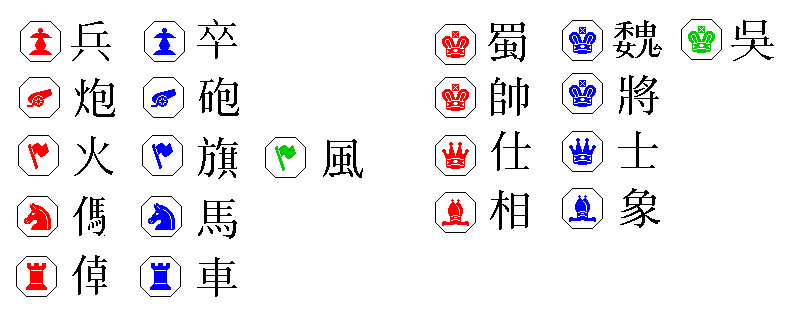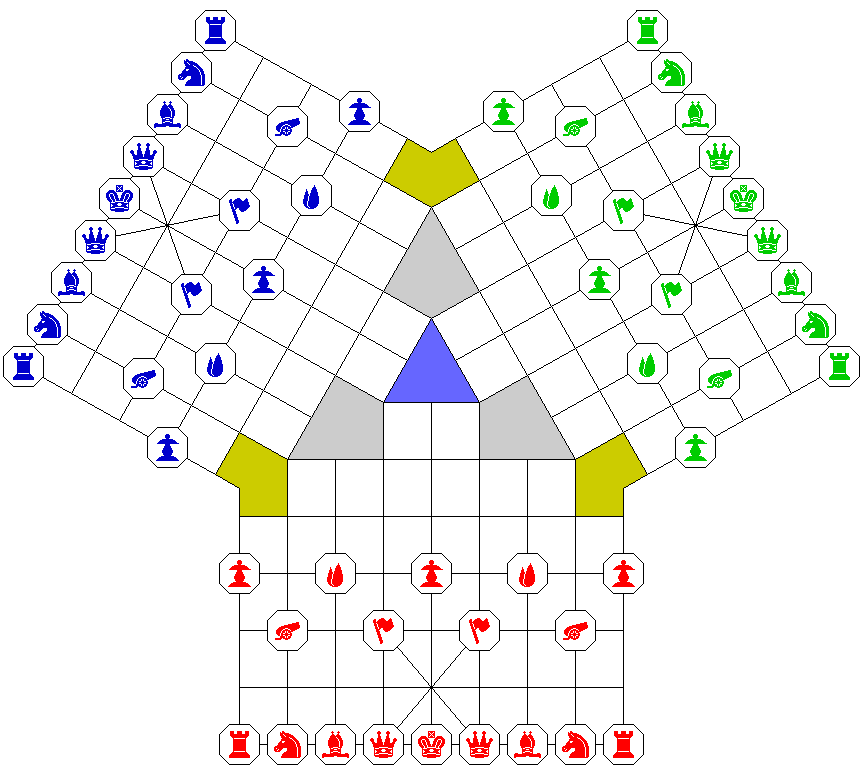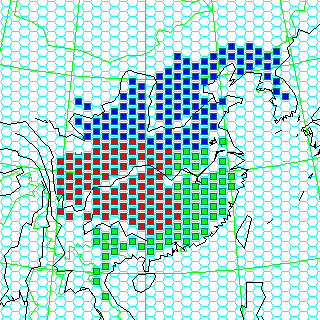
Having already mentioned the move of the new piece in this game on two previous pages, and having alluded to its charming hexagonal board on another, it seemed only reasonable that I would try to produce my own drawing of this interesting chessboard,

and devote a page to its game.
The rules are much as those of ordinary Chinese Chess:
The Pawn moves, and captures, forwards only until it crosses the middle line of the board, the river, after which it can move and capture sideways as well as forwards. It does not otherwise promote.
The Cannon moves as a Rook, but it captures along Rook lines as follows: it jumps over, without disturbing, the first man of either color on such a line, and then captures the next man on that line which must belong to the opponent.
The Flag has a move similar to that of the Camel in Timur's Chess, but is modified in the same way that the move of the Horse in this game differs from that of the Knight in conventional Chess: first, it moves two steps orthogonally, and then one step diagonally, with a 45-degree change of course, and intervening pieces can block it from making its move as they can block a Rook or Bishop from making a particular move.
The Rook (or Chariot) moves as in conventional Chess.
The Knight (or Horse) moves almost as in conventional Chess, except that its move consists of two steps, first an orthogonal move, and then a diagonal move involving only a 45-degree course change, and so it can be blocked by a piece on the intermediate square.
The piece shown as a Bishop (actually the Minister or Elephant, depending on which side it is on) moves always two squares diagonally, and can be blocked by an intervening piece. It cannot cross the river, but remains on its side of the board.
The piece shown as a Queen is the Counsellor, and moves one square diagonally; it cannot leave the nine-point area indicated by an X in the center of the back three rows of its own side.
The piece shown as a King is the General; it moves as a King in chess, except that it, like the Minister, cannot leave the nine-point area indicated by the X. Also, Generals of any two sides cannot face each other on an open file. Thus, if a General is in the central portion of the nine-castle, it prevents the other two Generals from being in its central column without intervening pieces, but if it is on the left or right side, it only affects the General whose home is towards that side of the board. Thus, the files are treated in the same way as they would be for normal Rook moves.
In this game, unlike the case in the seven-player game described on the preceding page, when one player checkmates another, instead of the pieces of the checkmated side being removed from the board, only the General is removed, and the checkmating player makes use of the additional pieces as part of his army.
Blue moves first, followed by Red, and then Green. Like the game on the previous page, it is inspired by a period in China's history, this time, one some 440 years later than that of the Warring States.
As noted, the chess pieces in a Chinese chess set are normally plain disks, with a raised character on them. Furthermore, the characters are sometimes different for the two sides. The following is a chart of the Chinese characters used, both for normal Chinese chess and the Game of the Three Kingdoms:

Not all the differences shown between the Red and the Blue chess pieces are present in all sets.
Note that the King is shown in two rows. In normal Chinese chess, the Red and Blue Generals are indicated by two different characters meaning General, as shown in the second row of two Kings; in the Game of the Three Kingdoms, the Red, Blue, and Green Generals are denoted by the names of their respective kingdoms, Shu, Wei, and Wu, as shown in the top row of three Kings.
The piece shown as a Flag that occurs only in the Game of the Three Kingdoms is denoted thusly: the Red Flag is indicated by the character for Fire, the Blue Flag is indicated by the character for Banner, and the Green Flag is indicated by the character for Wind.
The Red Cannon is shown with the character for Cannon; the Blue Cannon is shown with the character for Catapult, but sometimes the character for Cannon is used instead for the Blue team as well.
The Blue Knight is shown with the character for Horse, and the Blue Rook is shown with the character for Chariot, and the Blue Queen is shown with the character for Counsellor. In some sets, but not all, the respective Red pieces have a character with the "man" radical followed by the character used on the Blue pieces as the phonetic. It is more common for only the Counsellor to be differentiated in this way.
The Red Bishop is indicated by the character for Minister, and the Blue Bishop by the character for Elephant.
In the Game of the Three Kingdoms, it appears, although I am not certain, that the Pawns, Cannons, and Bishops of all three sides are indicated by the characters shown here for Red, and the Knights, Rooks, and Queens of all three sides are indicated by the characters shown here for Blue (which are also commonly used for Red as well in most sets for normal Chinese Chess with two sides). So, only the General and the Flag are different for the three sides in this game; no third form for even the Pawn and the Minister, which are shown differently on virtually all conventional Chinese Chess sets, is added.
The diagram below:

shows another form of The Game of the Three Kingdoms. Usually, when this board is illustrated, it is stated that it simply represents another way to draw the board for the same game. However, I have found out that when the game is played on this board, the rules are slightly different. Also, more recently, I have found a reference that refers to the game on this board as being a different game, The Game of the Three Friends, and which even has one Zheng Jinde (Cheng Chin-Te) credited as its inventor.
For one thing, instead of the Fire character being one of the alternate ways of naming the Flag piece, now the Fire piece and the Flag piece are two different pieces.
The Fire piece moves one space diagonally forwards.
The Flag piece has a different move in this version of the game; it moves one or two spaces orthogonally in its own territory, but in the territory of either opponent, it moves as the Chariot, that is, as the Rook in western Chess.
The blue triangle in the center of the board represents the sea, and neither the Chariot (Rook) or the Horse (Knight) can cross the sea. The gray areas represent mountain ranges, and the yellow areas represent city walls. The Cannon is blocked by both the mountain ranges and the city walls. (Note that for the city walls to block the Cannon, this means that the edges of these areas, not merely their interiors, act as a block to the pieces, which seems to mean that the Cannon can only cross between territories through the middle of the sea.)
And here is a diagram attempting to show, but only in an approximate fashion, where the Three Kingdoms were located within China, again in the form of a board wargame:

Several proprietary games of recent origin modify the western Chess board in the obvious way similar to that of this game to produce a three-player game. According to D. B. Pritchard's Encyclopedia of Chess Variants, now available in a revised edition, which, sadly, was completed poshumously, one is sold by the firm of Carter Hall, and its inventor is one Robert Zubrin. I wondered if he was the Robert Zubrin, of later fame for devising a means by which travel to Mars might be considerably more feasible, and have since found out that indeed he was; the patent on this game is the first one he had received, at the age of 20.
In an article in Popular Science magazine, he later proposed a game called "Martian Chess". One distinctive feature was that a player could use a captured piece to reclaim one of his own pieces of the same rank, to then drop on the board later; as in Shogi, placing a piece on the board counts as a move. In addition, a die is used, so that in each turn, a player can move from one to six men, but each piece can move only once in a turn. But on top of that, when a capture is attempted, the player making the attempt plays a card from a hand of 13 cards; the opponent replies, and the player taking the trick (highest card, following suit) removes the opponent's piece from the board. The intent, presumably, was to create a somewhat outré game which combined elements from diverse classes of game.
It might also be noted that Baltic Four-Handed Chess, invented (by Lionel Kieseritzky) some time before 1855, may have been the first attempt to apply the particular form of distortion of the gameboard used in the Game of the Three Kingdoms to Western Chess; here, the intent was to squeeze 720 degrees rather than 540 degrees into the circle, so that four half-chessboards might be conjoined. Early proposals for a Western version of three-player chess tended either to use a board based on hexagons or triangles, or to abut three boards at 120-degree angles with undistorted squares by means of multiple lattice defects; at least one game in this category, that of Waider, was featured on the cover of the book Chess Eccentricities by Major George Hope Verney, an influential figure in the development of four-handed Chess.
U. S. Patent 3,341,205 describes a game by one R. D. Dykes which stretches 270 degrees into a circle as another way to employ this type of distortion to create a symmetrical three-player game.
It should also be noted that Robert Zubrin's three-player chess game, although the design of its board is simply the natural extension of the same principle used in the Game of the Three Kingdoms, is credited with an important innovation by some accounts. According to the Wikipedia page on Robert Zubrin, the winner of his game is the first player to checkmate another player. This would appear to deal effectively with the two basic problems of a three-player game: that two players might temporarily combine against the third, and that a player could win too easily by playing defensively while the other two players fight to exhaustion. According to a TIME Magazine article on his game, however, the first player to checkmate another player simply adds that player's forces to his own, making his eventual victory likely, but not certain. His patent, U. S. Patent 3,652,091, however, does not include either of these innovations in the basic game it describes; instead, the pieces of the first player to be checkmated are immobilized, but are subject to capture. But the version described by the article in TIME Magazine is presented in the patent as an alternate form of play, although the patent states that this makes an alliance of two players more likely, rather than less, as I had mused above.